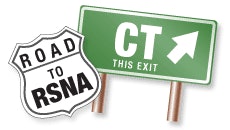Wide-area detectors, dual-source scanners, fast kV switching, and new contrast protocols that leverage CT's growing spatial and temporal resolution are important sides of the CT picture that will be showcased in presentations at this year's RSNA meeting in Chicago.
But equally important if not more so in 2011 is what's happening on the other side of the photon beam -- the image reconstruction and analysis side. There, researchers are honing techniques that boost the value of data acquisition in ways ranging from iterative reconstruction to material separation, from flow mapping to kV manipulation for reduced radiation dose and contrast.
Monochromatic imaging erases artifacts and makes low-dose scans easier to read. And software is becoming more adept at planning and implementing increasingly complex acquisition protocols. It is wielding image analysis to detect subtle attenuation differences and characterize patterns that better depict disease states, eliminate artifacts, measure tumors volumetrically, compensate for increased noise, and, of course, find pathology that the radiologist might have missed.

One intriguing session is a presentation on stress myocardial perfusion scans that match the accuracy of SPECT and MRI (SSC01-03). We're also featuring a study that links pericolonic fat to polyps (SST04-01), and another in which fatty liver disease is never mischaracterized by CT (SSE08-01). Another presentation looks at computer-aided detection via a database in the cloud (LL-INE1216).
Researchers from Germany are getting far better pulmonary embolism (PE) scans using high-pitch DSCT (MSVE21-10), and it's a win-win because patients don't have to stop breathing, and radiologists don't have to deal with the anatomic distortions that accompany the breath-hold. Meanwhile U.S. researchers quantify perfusion defects at PE and associate the results with patient outcomes (SSE05-04).
One study measures neoangiogenesis in liver tumors, distinguishing it from normal vasculature (SSG05-05). Another pits coronary artery calcium scoring against coronary CT angiography for diagnosis (SSA02-01).
Finally, a couple of overview presentations are must-sees, including Dr. Geoffrey Rubin's keynote speech on new developments in CT (PS10), and Dr. Ronald Boucher and colleagues' talk on life, death, and radiology in wartime Afghanistan (RC124), both on Sunday.
This being the RSNA meeting, you won't be able to see half of what piques your interest, but we hope this preview will help get you started. For more information, check out the RSNA's online program.



















